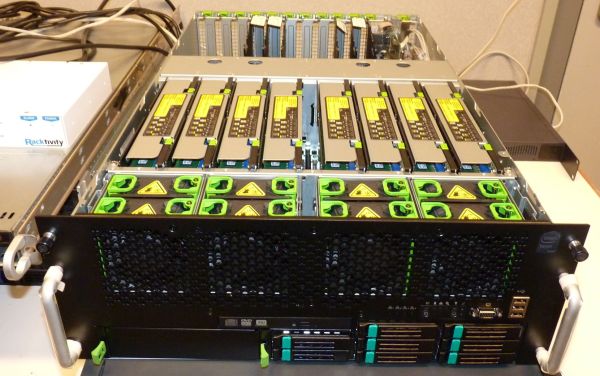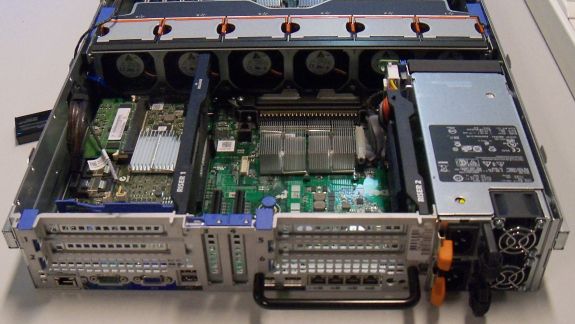Westmere-EX: Intel's Flagship Benchmarked
by Johan De Gelas on May 19, 2011 1:30 PM EST- Posted in
- IT Computing
- Intel
- Xeon
- Cloud Computing
- Westmere-EX
Intel Quanta QSCC-4R Benchmark Configuration
| CPU |
4x Xeon X7560 at 2.26GHz or 4x Xeon E7-4870 at 2. 4GHz |
| RAM | 16x4GB Samsung Registered DDR3-1333 at 1066MHz |
| Motherboard | QCI QSSC-S4R 31S4RMB00B0 |
| Chipset | Intel 7500 |
| BIOS version | QSSC-S4R.QCI.01.00.S012,031420111618 |
| PSU | 4x Delta DPS-850FB A S3F E62433-004 850W |
The Quanta QSCC-4R is an updated version of the server we reviewed a year ago. The memory buffers consume less power and support low power (1.35V) DDR3 ECC DIMMs. The server can accept up to 64x32GB Load Reduced DIMMs (LR-DIMMs), so the new server platform can offer up to 2TB of RAM!
LR-DIMMs are the successors of FB-DIMMs. Fully Buffered DIMMs reduced the load on the memory channel courtesy of a serial interface between the memory controller and the AMB. The very high serial input frequency however increased the heat generation significantly, so the memory vendors abandoned FB-DIMMs after DDR2. Until recently, all large DDR3 DIMMs have been registered DIMMs.
The new Load Reduced DIMM is a registered DIMM on steroids that buffers the address signals just like registered DIMMs, but it also buffers the datalines. LR-DIMMs therefore fully buffer the DIMMs and greatly increase the number of memory chips that can be used per channel without the power hogging serial interface of the AMBs. The downside is that buffering the datalines increases latency, especially with bus turnarounds.
The QSSC-4R comes with a rich BIOS. Below you can see the typical BIOS configuration that we used. As you can see we tested the Xeon with Turbo Boost and Hyper-Threading enabled.
Dell PowerEdge R815 Benchmarked Configuration
| CPU | 4x Opteron 6174 at 2.2GHz |
| RAM | 16x4GB Samsung Registered DDR3-1333 at 1333MHz |
| Motherboard | Dell Inc 06JC9T |
| Chipset | AMD SR5650 |
| BIOS version | v1.1.9 |
| PSU | 2x Dell L1100A-S0 1100W |
The R815 is not a direct competitor to the quad Xeon platform; it is more limited in RAS features and expandability (512GB of RAM max). However, it is an attractive alternative for some of the more cost sensitive quad Xeon buyers. Its very compact 2U design takes half the space of the quad Xeon servers, and a fully equipped quad Opteron server with 256GB of RAM can be purchased for less than $20,000. A similar quad Xeon system can set you back $30,000 or more.
Storage Setup
The storage setup is the same as what we described here.













62 Comments
View All Comments
Shadowmaster625 - Friday, May 20, 2011 - link
Yeah but what you gonna do with those two extra Xeons? You cant just bolt them to the side of that two socket server. There is a huge price divide between 2 and 4 socket servers. Your numbers are totally disingenuous. You'd need to drop an extra 6 grand just to move into the 4 socket platform. You can see that right on HP's site. For $12,000 more you get 2 extra sockets, and all four chips get upgraded to 4850s. The upgrade is worth 4 grand. You also get a memory upgrade to 128GB. When you also subtract a couple grand for that 64GB of ram upgrade, you're left with 6 grand for the dual-to-quad socket upgrade.btw you posted the same link twice.
jihadjoe - Saturday, May 21, 2011 - link
Spec sheet, from GP's link:http://h18000.www1.hp.com/products/quickspecs/1366...
It's a 4-socket server but 'as configured' comes with two processors. You put those extra xeons in the two extra sockets inside it.
Shadowmaster625 - Monday, May 23, 2011 - link
So why is the 4 core server $6000 more expensive, when factoring out the added parts? Is that what they charge just to install two processors? Is there really that much waste in the IT world? If so then it is no wonder IT is being outsourced at a breakneck pace. Any IT professional who would pay HP 6 grand just to install a couple cpu's needs to be "downsized" immediately.JarredWalton - Monday, May 23, 2011 - link
The AMD server is here:http://h10010.www1.hp.com/wwpc/us/en/sm/WF06b/1535...
It only supports 32 DIMMs vs. 64 DIMMs, as another disadvantage.
As L. points out below, the Intel setup is also using the E7-4830, which is 8 core instead of 10. And then the upgraded Intel setup with 10-core CPUs also bumps up to 128GB RAM and 4 x 1200W PSUs and ends up at $26819 (with 4 x E7-4850) -- note that the AMD setup already had 4 x 1200W PSUs.
So once again, we're back to comparing apples and pears -- similar in many ways, but certainly not identical. And for that very reason, you can't even begin to make statements like L.'s "AMD wins on perf/watt/dollar" because we don't have any figures for how much power such an AMD setup actually consumes compared to the Intel setup. It might be more power than our review servers, or it might be less, but it will almost certainly be different.
My main point is that we're not even remotely close to paying 2x as much for an Intel server vs. AMD server. If you want to compare the cheapest quad-Opteron 6174 to a higher quality quad-Xeon, yes, the pricing will be vastly different; that's like pointing out that a luxury sedan costs more than the cheapest 4-door midsize sedan.
L. - Monday, May 23, 2011 - link
I think I saw that comment quite a few times .. but I only just realized there was a big problem with your numbers :The processors listed here are e7-4830.
Those processors are 8 cores (not 10 like 4870) and 2.13Ghz (not 2.4Ghz like 4870).
Assuming linear scaling (although this is absolutely not the case) you would get the same perf/watt as the above model, and a total sap score of 52,518 vs 47,420 for the AMD 6174 (10% more).
And the price is 18% more .. looks like perf/watt/dollar crown goes to AMD again.
Other tests are clearly impossible to guesstimate and clearly the SAP test was where the e7 was getting a better advantage compared to vAPUs mark II test.
So yes, the argument stands that even though Intel has higher-priced extreme components, anything they have in AMD-performance-range is more expensive than AMD's option, quite logical with AMD as the underdog so far.
BUT, as we're showing benchmark of the flagship vs flagship, there tends to be misconceptions about the rest of the product line, just like here "20k more expensive" or "so much better cpu from intel" or other random bullcrap.
spanky_mcsoreass - Thursday, May 19, 2011 - link
What software does the average business need to run on a ridiculous number of cores? The only common application that comes to mind is internet facing Linux/Apache servers, and Linux/Apache are free(anyone dumb enough to pay for and use Windows/IIS deserves what they get).Most businesses just need a lot of VMs running their various low intensity apps, and dedicated NAS or SAN devices. Magny-Cours Opteron devices do either just as well or better than Xeon, and using VMs to run licensed apps won't result in a penalty for software licensing.
ggathagan - Thursday, May 19, 2011 - link
Then this really isn't for "most businesses", is it?This is Intel's new flagship.
As such I do not expect it to be a good fit for many businesses out there.
That does not make it any less interesting to review, since there are businesses that *can* make use of it.
Further, the same technology will end up in the lower tier CPU's as well.
dominique_straws_con - Thursday, May 19, 2011 - link
No, this is just another CPU that *could* be for most businesses, you could use it in the "lots of non-intensive apps running in VMs" scenario(or any other scenario), it's just an exceptionally poor value, and will probably not out-perform Magny-Cours or Bulldozer for most people's real world use. This CPU excels at benchmarking, and that's just about it.AMD got server CPUs right, it's all about how many cores you can fit on a rack.
L. - Friday, May 20, 2011 - link
How many cores you can fit on a rack, with what TDP ;)When you have to WC your rack, you have a problem - most of the time anyway.
Casper42 - Thursday, May 19, 2011 - link
You know nothing about Enterprise level IT.Your Example of Internet Facing Apps and Linux Apache is the EXACT opposite design methodology of how things work in the real world.
In the real world, internet apps run on the cheapest of the cheap servers and companies just use a ton of them behind a Load Balancer.
Now the Database serving those web servers in the background, running Oracle RAC or MS SQL or even MySQL on the other hand will make use of all these cores and memory assuming you have a large database.
The examples given RIGHT IN THE ARTICLE about things like SAP are probably the most common thing run on these Big Iron type boxes.
If it helps prove my point any further, over at HP on the Sales side of things, the guys that have been selling RISC based machines under the HP Integrity/Superdome name for something like a decade, are now also being paid commission when they sell the DL580/DL980 G7 servers. Those 2 models use the Nehalem EX and will soon be using the Westmere EX.
So the type of Apps running on these CPUs are often the same things Fortune 100 companies used to run on Integrity/Sun/IBM Power/etc